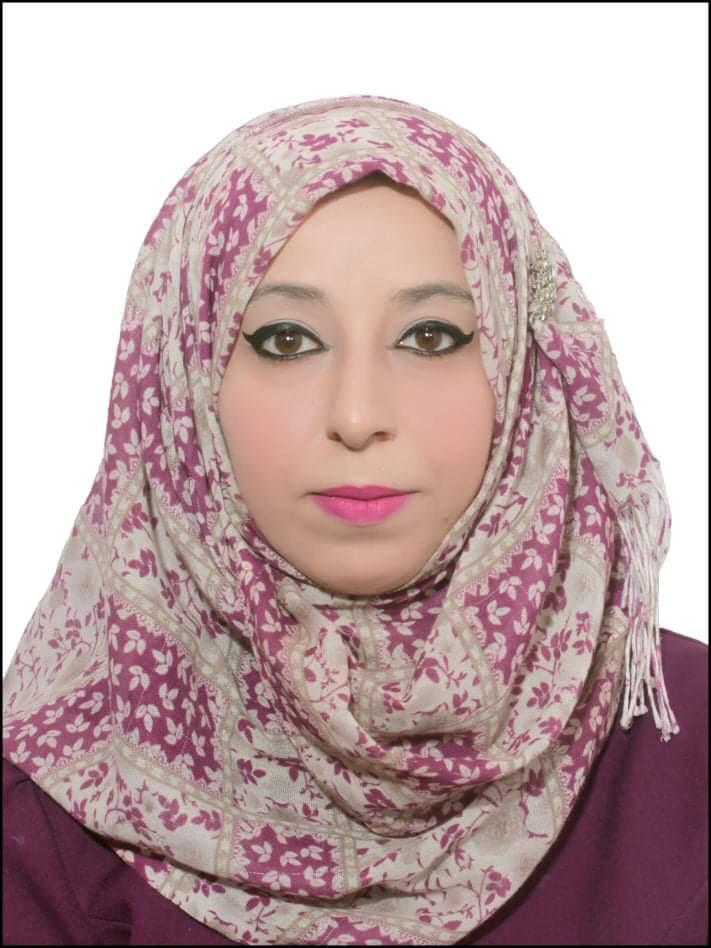
Zinah Amer Idrees Alshrefy
Research InterestsEnvironmental Engineering
pollution
Wastewater treatment
water treatment
Noise Pollution
Air Pollution
| Gender | FEMALE |
|---|---|
| Place of Work | Presidency |
| Position | Division Director |
| Qualification | Master |
| Speciality | Civil engineering/environmental engineering |
| zena.alshrefy@ntu.edu.iq | |
| Phone | 00000000 |
| Address | Iraq/Mosul, lecturer, Mosul, Iraq |

Dr.Zinah Amer Idrees Al-Shrefy is a lecturer at the University Presidency, Department of Quality Assurance and University Performance at the Northern Technical University (NTU). Dr. Al-Sharifi is an outstanding academic and researcher, currently holding the position of Head of the Quality Assurance Division and Head of the Institutional Accreditation Unit within the Department of Quality Assurance and University Performance. She is also a lecturer in the Department of Chemical Industries at the Mosul Technical Institute, part of the Northern Technical University (NTU).
Dr. Al-Shrefy obtained her Master's degree in Civil Engineering from the University of Mosul in 2012, specializing in Environmental Engineering, where her research significantly contributed to the development of this field. She also earned her Bachelor's degree in Civil Engineering from the same university in Iraq in 2008.
An active researcher and author, Dr. Al-Shrefy has published more than 13 peer-reviewed articles, many of which are indexed in prestigious academic databases, including Scopus and Web of Science. Her scientific impact is reflected in her citation metrics, with over 40 citations on Google Scholar (with an h-index of 3) and 33 citations on Scopus (with an h-index of 3). Dr. Al-Sharifi’s research focuses primarily on Environmental Engineering, environmental pollution, wastewater treatment, and drinking water purification, with diverse applications in multiple fields, including healthcare.
In addition to her research and teaching roles, Dr. Al-Sharifi serves as a renowned reviewer for several prestigious academic journals, including the Ain Shams Engineering Journal, Case Studies in Chemical and Environmental Engineering, Environmental Technology & Innovation, Heliyon, and others, all indexed in the Web of Science (WOS). Her expertise contributes to the field of Environmental Engineering and sustainability.
Skills
persian (70%)
English (85%)
Arabic (100%)
Epanet (70%)
Autocad (70%)
Academic Qualification
M.Sc. in Civil Engineering/Environmental Engineering
Sep 1, 2010 - Feb 26, 2012- University of Mosul Sep 1, 2010 - Feb 26, 2012M.Sc. research focused on Environmental Engineering
Bsc
Sep 1, 2004 - Jul 25, 2008Civil Engineering
Working Experience
Global and Local Rankings [Quality Assurance, Northern Technical University, Mosul, Iraq]
Dec 31, 2017 - PresentFocused on Global and Local Rankings
Publications
The Impact of Fluid Flow on Microbial Growth and Distribution in Food Processing Systems
Jan 1, 2025Journal Foods
publisher Multidisciplinary Digital Publishing Institute (MDPI)
Issue Issue 3
Volume Volume 14,
bstract This article examines the impact of fluid flow dynamics on microbial growth, distribution, and control within food processing systems. Fluid flows, specifically laminar and turbulent flows, significantly influence microbial behaviors, such as biofilm development and microbial adhesion. Laminar flow is highly conducive to biofilm formation and microbial attachment because the flow is smooth and steady. This smooth flow makes it much more difficult to sterilize the surface. Turbulent flow, however, due to its chaotic motion and the shear forces that are present, inhibits microbial growth because it disrupts attachment; however, it also has the potential to contaminate surfaces by dispersing microorganisms. Computational fluid dynamics (CFD) is highlighted as an essential component for food processors to predict fluid movement and enhance numerous fluid-dependent operations, including mixing, cooling, spray drying, and heat transfer. This analysis underscores the significance of fluid dynamics in controlling microbial hazards in food settings, and it discusses some interventions, such as antimicrobial surface treatments and properly designed equipment. Each process step from mixing to cooling, which influences heat transfer and microbial control by ensuring uniform heat distribution and optimizing heat removal, presents unique fluid flow requirements affecting microbial distribution, biofilm formation, and contamination control. Food processors can improve microbial management and enhance product safety by adjusting flow rates, types, and equipment configurations. This article helps provide an understanding of fluid–microbe interactions and offers actionable insights to advance food processing practices, ensuring higher standards of food safety and quality control. © 2025 by the authors.
A Review of Fluid Flow Applications and Hydraulic Performance of Sustainable Drip Irrigation to Improve Water Resource Management
Aug 11, 2023Journal Tikrit Journal of Engineering Sciences
publisher Tikrit University
Issue 3
Volume 30
Abstract Fluid flow applications to improve water resource management towards sustainable irrigation are one of the main targets of engineers nowadays, especially with global climate change. The performance assessment of the irrigation system is an important area of research to improve water resource management. Through drip irrigation systems, this review evaluated the application uniformity of water and nutrients to sustain agricultural production and protect the environment’s natural resources. To achieve these goals, the adequate use of nutrients and water must be emphasized by utilizing sufficient water and nutrient management approaches, including a drip irrigation system that supplies the inputs immediately to the crop’s root zone. The process operating pressure and the drip line length are the two most crucial aspects that affect the uniformity of the water and nutrient distribution in fields. Inconsistent or inadequate applications of fertilizers and water in the fields contribute to the incorrect supply of useful water and nutrients in the soil profile along the drip line length resulting in a significant decrease in crop yields and poor product quality. The main cause behind the operating pressures in a “micro-irrigation system” is the inadequate distribution of fertilizers and water in the fields. Therefore, the effects of such non-uniform distribution must be carefully quantified and studied to understand the reasons behind soil degradation and groundwater contamination, which occurs due to excess nutrient leaching from the crop’s root zone. Data on the distribution and movement of water and nutrients in the soil is essential for designing efficient fertilization systems. Drip irrigation can reduce water exposure and input costs, making agribusiness more resilient, profitable, and successful. This paper discusses the uniformity of the nutrients and water application for crops grown in various agro-climatic regions. In addition, an effort was made to compare the findings’ quality of various commonly used methods of water and nutrient application under different climatic conditions
Using GIS model to investigate sustainable irrigation techniques from wastewater
Jul 14, 2023Journal AIP Conference Proceedings
publisher American Institute of Physics Inc.
Issue 2787
Volume 1
Abstract This work was done to investigate the distinguishing features of the flow of wastewater and the possibility of using it for irrigation purposes as a sustainable method in the future. The wastewater utilized in this case study was obtained from six different areas in Baghdad, Iraq, and was collected for analysis. A large number of wastewater samples have been collected from six distinct locations: al-Karkh project, south Rustomiya project, north Rustomiya project, Al-Rustomiya project, Al-Shaab project, and Hay al-Mustansiryia project. Several tests have been done to ensure the grey water validity for agricultural uses; these tests are PH, Cl, NO3, PO4, SO4 and phenols. Geographic Information System (GIS) was used to locate and present the results of the wastewater properties from the six projects in Baghdad. The results indicated that the wastewater contains a significant amount of phosphate, sulfate and nitrate, which is the fertilizer of the soil. Although this water cannot be utilized for irrigation directly, it must be primarily treated and then it can be used for irrigation safely in the future. © 2023 Author(s).
Evaluation of environmental noise pollution in Mosul
Jul 14, 2023Journal AIP Conference Proceedings
publisher American Institute of Physics Inc.
Issue 2787
Volume 1
Abstract Noise pollution, as compared to other environmental pollutions, increases rapidly and has a short decay period. This study investigates the noise pollution level inside Mosul city in Iraq at seven sites situated in different locations inside Mosul city. Four separate locations were selected to measure noise levels within the city located in different locations to evaluate the city's noise pollution levels: residential areas, commercial areas, residential areas near highways, and residential areas. The noise level was measured using the noise level meter in all studied sites (day, evening, and night). The reading was recorded every 5 seconds, This includes LAFmax, LAFmin, and LAeq (the equivalent continuous level), which measure the highest and minimum noise levels over a period of time, respectively, and the particular value that must be determined for each reading. The measuring time ranged between 10 and 15 minutes. The measured noise levels in the residential zones were within the Environmental Protection Law's permitted limits. The greatest noise pollution level was recorded at site No. 2 (Mosul municipality/Al-Refaq neighborhood), were attributed to its close to major roads, commercial centers, and government buildings which exacerbated noise levels. © 2023 Author(s).
Validating Sustainable Water Resources And Fluid Flow By Studying Phosphorus Concentration Of Tigris River Water In Baghdad
Nov 17, 2022Journal AIP Conference Proceedings
publisher American Institute of Physics Inc.
Issue 2660
Abstract Water pollution poses one of the major global threats for any political and scientific communities impairing life and health, damaging industrial activities as well as sustainable growth and development of a civilization. In Iraq, population and industrial expansion in the city of Baghdad and major cities has led to the establishment of many industrial projects in various areas. The presence of harmful substances in small quantities from these plants to the river directly does not cause water pollution, but there accumulation for a long time pose a threat to the quality of water as well its environment and organisms such as fish, aquatic animals that harbor that habitat. Water pollution in general is demonstrated by the decrease or increase of dissolved oxygen, the increase in dissolved nutrients, the increase of water polarity and its effect on light penetration. Therefore, the current study aimed to evaluate the qualitative changes (phosphorus concentrations) in the Tigris River water in Baghdad city by assessing the river water quality in various seasons of the year. The study has used the ongoing water treatment projects such as Al- wahda, Al- rashed, Al- karama, Al- wthba, Al- doura, Al- qadisiya, Um al- khanazeer, Shark dijjila and Al- khademya. in the Baghdad city as raw water sources. Furthermore, the study also emphasized the effect of water quality in Tigris River produced from water purification projects of Baghdad city that sites the river path. Chemical tests were conducted on the collected samples in order to identify the main environmental problems affecting the Tigris water quality from the polluted areas and finally identifying ways to reduce the degree of pollution to reach the best ways to protect the aquatic environment. Simultaneously, some toxic ions have also been tested from these samples from seven water stations on the Tigris River in Baghdad. A study of the water of Nehridgele has been conducted in winter and spring, and were compared with the data from the past years (Data taken from Ministry of Environment, Water Resources, and Baghdad Municipality). This study is an investigative survey of the pollutants of the Tigris River passing through the city of Baghdad and the identification of polluted areas in the river water, which will serve as a guide for all workers in this field. © 2022 American Institute of Physics Inc.. All rights reserved.
IoT and E-learning with the Impact of COVID 19 Pandemic Lockdown on the Undergraduate University Student Blood Pressure Levels
Jul 7, 2022publisher CEUR-WS
Issue 3149
CEUR Workshop Proceedings
Physic-chemical survey of bottled and tap water in Iraq
Jan 1, 2021Journal Journal of Green Engineering
publisher Alpha Publishers
Issue 11
Volume 1
Abstract The study aimed to evaluate the bottled water quality in northern of Iraq. One hundred ninety two sachets of water samples from the four bottled water types were collected from the factories and network tap water and examined in the first half of 2019 in Mosul city in northern of Iraq, and assessed their suitability for drinking and human consumption through some physic-chemical features, which are pH, turbidity, total dissolved solid, total hardness and other main cation and anions such as calcium and magnesium, also nitrate and chloride, iron, lead, copper, cadmium, and manganese, and also micro and biological examinations. The results showed that most of the collected water samples didn`t comply with Iraq and WHO guidelines due to the exceeds of turbidity values of some bottled water and also tap water in the city, also the levels of microbiological parameters were exceeded the guideline value. The study found that the variation of water quality depends on storage conditions and also the deterioration of water quality were very high in sunlight and shadow storage conditions during the period of storage (4 months) while at refrigerator and room storage conditions; the impacts were lower. The results showed that, the values of plastic residue were highly increased with storage period at sunlight storage. The observation illustrated that, the values of total bacterial count and total algal count were highly increased with storage period at sunlight storage. The study may be do a warning and attention for the decision maker in city to avoid the human health risks. © 2021 Alpha Publishers. All rights reserved.












